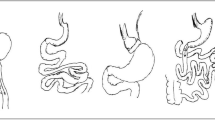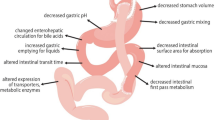Abstract
Background
Unknown hormonal and neural satiety signals are thought to drive sustainable weight loss following laparoscopic adjustable gastric banding (LAGB). The objective of this study was to investigate whether the structurally related satiety hormones pancreatic polypeptide (PP) and peptide YY (PYY) influence total percentage weight loss after LAGB.
Methods
A cross-sectional study examined 17 postoperative individuals who had already achieved a mean of 28% LAGB-induced weight loss (range, 10–38%). A prospective study assessed plasma PP and PYY meal responses in 16 obese individuals prior to LAGB.
Results
In the cross-sectional study, individuals with higher weight loss had lower PP meal responses (2-h AUC, R = −0.60, p = 0.01) and lower fasting PYY levels (R = −0.55, p = 0.02). In the prospective study, subsequent mean weight loss was 20% (range, 5–50%) after a mean of 53 months. Low preoperative PP meal response (2-h AUC) predicted significantly higher subsequent weight loss after LAGB (R = −0.56, p = 0.024). The eight individuals with the lowest PP meal response lost more weight than the eight with the highest PP meal response (median 25% vs. 14%, p = 0.004). When compared across all three groups, mean PP meal responses did not differ. Fasting PYY levels, however, were significantly lower in the postoperative group compared to the group tested pre-operatively, or the BMI-matched controls (−30%, p = 0.03).
Conclusions
PYY appears reduced in proportion to weight loss following LAGB, possibly representing attempted orexigenic homeostatic compensation. Although PP responses appear unchanged by weight loss status, low PP meal response may predict higher weight loss. PP meal response may be a biological marker that could predict an individual's susceptibility to the mechanism underlying LAGB-induced weight loss.




Similar content being viewed by others
Notes
Please note that for the comparison with BMI-matched controls, the 0900 PYY levels of the postoperative patients was the mean of the 0900 PYY levels measured on both testing occasions (‘optimal’ and ‘reduced’ restriction).
References
Adrian TE, Bloom SR, Bryant MG, et al. Distribution and release of human pancreatic polypeptide. Gut. 1976;17:940–4.
Adrian TE, Ferri GL, Bacarese-Hamilton AJ, et al. Human distribution and release of a putative new gut hormone, peptide YY. Gastroenterology. 1985;89:1070–7.
Jayasena CN, Bloom SR. Role of gut hormones in obesity. Endocrinol Metab Clin North Am. 2008;37:769–87. xi.
Neary NM, McGowan BM, Monteiro MP, et al. No evidence of an additive inhibitory feeding effect following PP and PYY 3–36 administration. Int J Obes (Lond). 2008;32:1438–40.
Batterham RL, Cohen MA, Ellis SM, et al. Inhibition of food intake in obese subjects by peptide YY3-36. N Engl J Med. 2003;349:941–8.
le Roux CW, Batterham RL, Aylwin SJ, et al. Attenuated peptide YY release in obese subjects is associated with reduced satiety. Endocrinology. 2006;147:3–8.
Sjostrom L, Narbro K, Sjostrom CD, et al. Effects of bariatric surgery on mortality in Swedish obese subjects. N Engl J Med. 2007;357:741–52.
O'Brien PE, McPhail T, Chaston TB, et al. Systematic review of medium-term weight loss after bariatric operations. Obes Surg. 2006;16:1032–40.
le Roux CW, Aylwin SJ, Batterham RL, et al. Gut hormone profiles following bariatric surgery favor an anorectic state, facilitate weight loss, and improve metabolic parameters. Ann Surg. 2006;243:108–14.
Korner J, Bessler M, Cirilo LJ, et al. Effects of Roux-en-Y gastric bypass surgery on fasting and postprandial concentrations of plasma ghrelin, peptide YY, and insulin. J Clin Endocrinol Metab. 2005;90:359–65.
Shak JR, Roper J, Perez-Perez GI, et al. The effect of laparoscopic gastric banding surgery on plasma levels of appetite-control, insulinotropic, and digestive hormones. Obes Surg. 2008;18:1089–96.
Hanusch-Enserer U, Ghatei MA, Cauza E, et al. Relation of fasting plasma peptide YY to glucose metabolism and cardiovascular risk factors after restrictive bariatric surgery. Wien Klin Wochenschr. 2007;119:291–6.
Bose M, Machineni S, Olivan B, et al. Superior appetite hormone profile after equivalent weight loss by gastric bypass compared to gastric banding. Obesity (Silver Spring). 2010;18:1085–91.
Korner J, Inabnet W, Febres G, et al. Prospective study of gut hormone and metabolic changes after adjustable gastric banding and Roux-en-Y gastric bypass. Int J Obes (Lond). 2009;33:786–95.
Dixon AF, Dixon JB, O'Brien PE. Laparoscopic adjustable gastric banding induces prolonged satiety: a randomized blind crossover study. J Clin Endocrinol Metab. 2005;90:813–9.
Adrian TE, Bloom SR, Bryant MG, et al. Proceedings: radioimmunoassay of a new gut hormone-human pancreatic polypeptide. Gut. 1976;17:393–4.
Faraj M, Havel PJ, Phelis S, et al. Plasma acylation-stimulating protein, adiponectin, leptin, and ghrelin before and after weight loss induced by gastric bypass surgery in morbidly obese subjects. J Clin Endocrinol Metab. 2003;88:1594–602.
Morinigo R, Vidal J, Lacy AM, et al. Circulating peptide YY, weight loss, and glucose homeostasis after gastric bypass surgery in morbidly obese subjects. Ann Surg. 2008;247:270–5.
Holdstock C, Zethelius B, Sundbom M, et al. Postprandial changes in gut regulatory peptides in gastric bypass patients. Int J Obes (Lond). 2008;32:1640–6.
Adrian TE, Besterman HS, Cooke TJ, et al. Mechanism of pancreatic polypeptide release in man. Lancet. 1977;1:161–3.
Taylor IL, Feldman M. Effect of cephalic-vagal stimulation on insulin, gastric inhibitory polypeptide, and pancreatic polypeptide release in humans. J Clin Endocrinol Metab. 1982;55:1114–7.
Kral JG. Vagotomy as a treatment for morbid obesity. Surg Clin North Am. 1979;59:1131–8.
Kronborg O. Truncal vagotomy and drainage in 500 patients with duodenal ulcer. Scand J Gastroenterol. 1971;6:501–9.
Goligher JC, Pulvertaft CN, Irvin TT, et al. Five- to eight-year results of truncal vagotomy and pyloroplasty for duodenal ulcer. Br Med J. 1972;1:7–13.
Kral JG, Gortz L, Hermansson G, et al. Gastroplasty for obesity: long-term weight loss improved by vagotomy. World J Surg. 1993;17:75–8. discussion, 9.
Angrisani L, Cutolo PP, Ciciriello MB, et al. Laparoscopic adjustable gastric banding with truncal vagotomy versus laparoscopic adjustable gastric banding alone: interim results of prospective randomized trial. Surg Obes Relat Dis. 2009;5:435–8.
Camilleri M, Toouli J, Herrera MF, et al. Intra-abdominal vagal blocking (VBLOC therapy): clinical results with a new implantable medical device. Surgery. 2008;143:723–31.
Business Wire. EnteroMedics announces preliminary results of its EMPOWER(TM) study. http://ir.enteromedics.com/releasedetail.cfm?ReleaseID=413254(2009). Accessed 31 December 2010.
Koren MS, Holmes MD. Vagus nerve stimulation does not lead to significant changes in body weight in patients with epilepsy. Epilepsy Behav. 2006;8:246–9.
Burneo JG, Faught E, Knowlton R, et al. Weight loss associated with vagus nerve stimulation. Neurology. 2002;59:463–4.
Bugajski AJ, Gil K, Ziomber A, et al. Effect of long-term vagal stimulation on food intake and body weight during diet induced obesity in rats. J Physiol Pharmacol. 2007;58 Suppl 1:5–12.
Laskiewicz J, Krolczyk G, Zurowski G, et al. Effects of vagal neuromodulation and vagotomy on control of food intake and body weight in rats. J Physiol Pharmacol. 2003;54:603–10.
Cigaina V, Hirschberg AL. Gastric pacing for morbid obesity: plasma levels of gastrointestinal peptides and leptin. Obes Res. 2003;11:1456–62.
Cigaina V, Hirschberg AL. Plasma ghrelin and gastric pacing in morbidly obese patients. Metabolism. 2007;56:1017–21.
Bohdjalian A, Prager G, Aviv R, et al. One-year experience with Tantalus: a new surgical approach to treat morbid obesity. Obes Surg. 2006;16:627–34.
Luo J, Al-Juburi A, Rashed H, et al. Gastric electrical stimulation is associated with improvement in pancreatic exocrine function in humans. Pancreas. 2004;29:e41–4.
Koska J, DelParigi A, de Courten B, et al. Pancreatic polypeptide is involved in the regulation of body weight in pima Indian male subjects. Diabetes. 2004;53:3091–6.
Pfluger PT, Kampe J, Castaneda TR, et al. Effect of human body weight changes on circulating levels of peptide YY and peptide YY3-36. J Clin Endocrinol Metab. 2007;92:583–8.
Alderdice JT, Dinsmore WW, Buchanan KD, et al. Gastrointestinal hormones in anorexia nervosa. J Psychiatr Res. 1985;19:207–13.
Uhe AM, Szmukler GI, Collier GR, et al. Potential regulators of feeding behavior in anorexia nervosa. Am J Clin Nutr. 1992;55:28–32.
Kinzig KP, Coughlin JW, Redgrave GW, et al. Insulin, glucose, and pancreatic polypeptide responses to a test meal in restricting type anorexia nervosa before and after weight restoration. Am J Physiol Endocrinol Metab. 2007;292:E1441–6.
le Roux CW, Welbourn R, Werling M, et al. Gut hormones as mediators of appetite and weight loss after Roux-en-Y gastric bypass. Ann Surg. 2007;246:780–5.
Korner J, Inabnet W, Conwell IM, et al. Differential effects of gastric bypass and banding on circulating gut hormone and leptin levels. Obesity (Silver Spring). 2006;14:1553–61.
Tice JA, Karliner L, Walsh J, et al. Gastric banding or bypass? A systematic review comparing the two most popular bariatric procedures. Am J Med. 2008;121:885–93.
Burton PR, Yap K, Brown WA, et al. Changes in satiety, supra- and infraband transit, and gastric emptying following laparoscopic adjustable gastric banding: a prospective follow-up study. Obes Surg. 2011;21:217–23.
de Jong JR, van Ramshorst B, Gooszen HG, et al. Weight Loss After laparoscopic adjustable gastric banding is not caused by altered gastric emptying. Obes Surg. 2009;19:287–92.
VozarovadeCourten B, Weyer C, Stefan N, et al. Parasympathetic blockade attenuates augmented pancreatic polypeptide but not insulin secretion in Pima Indians. Diabetes. 2004;53:663–71.
Acknowledgements
We thank Dr. Belinda Drew for her assistance in performing the meal tests.
Funding and Potential Conflict of Interest Disclosures
The research was supported by Inamed Health, now owned by Allergan Inc., the manufacturer of the Lap-Band system, through an unrestricted research grant to Monash University. John Dixon is a Consultant for Allergan Inc. and receives research support funding. Andrew Dixon, Carel le Roux, Mohammed Ghatei, Stephen Bloom and Toni McGee have no conflicts of interest to declare.
Author information
Authors and Affiliations
Corresponding author
Rights and permissions
About this article
Cite this article
Dixon, A.F.R., le Roux, C.W., Ghatei, M.A. et al. Pancreatic Polypeptide Meal Response May Predict Gastric Band-Induced Weight Loss. OBES SURG 21, 1906–1913 (2011). https://doi.org/10.1007/s11695-011-0469-z
Published:
Issue Date:
DOI: https://doi.org/10.1007/s11695-011-0469-z




